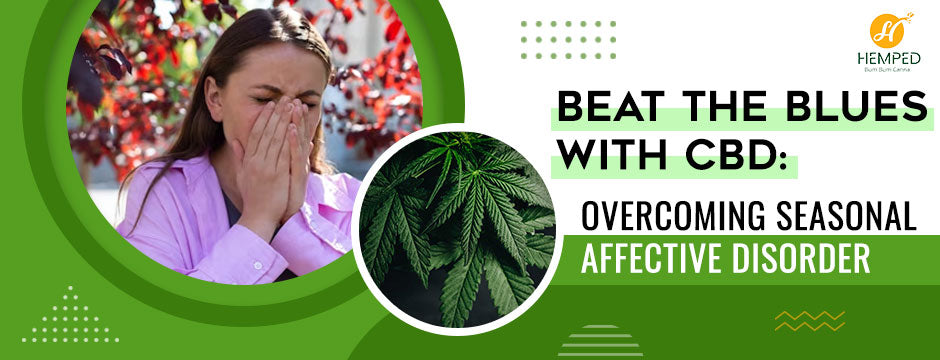
Beat The Blues With CBD: Overcoming Seasonal Affective Disorder
Do the cold months make you feel down and out? If this is the case, you may suffer from seasonal depression, commonly known as a seasonal affective disorder. But what is SAD, and what causes it? Today, we'll look at this seasonal health concern, its symptoms, and if you can use CBD for depression and seasonal affective disorder.
Seasonal depression is a mood condition that coincides every year. For example, while winter sadness is more common, a rare seasonal depression known as "summer depression" begins in late spring or early summer. On the other hand, seasonal affective disorder typically starts in the fall or winter and ends in the spring or early summer.
Table of Contents
What is Seasonal Affective Disorder?
Seasonal Affective Disorder is a mood disorder that affects some people at the same time of year. Most people associate that time of year with fall and winter when there is less daylight and we spend less time outside. However, some people also experience increased feelings of depression or anxiety. A continual sadness or crankiness, increased appetite and weight gain, exhaustion, concentration issues, a need to be alone, and even suicidal thoughts are all warning indicators.
Seasonal affective disorder is associated with decreased sunshine exposure, which affects the body's internal clock and the brain's release of chemicals such as serotonin. Many people confess that their general mood is lowest during the winter because of the restricted exposure to sunlight. Making lifestyle changes such as exercising frequently and controlling stress are methods to combat this. Furthermore, many people swear that CBD for depression may help you combat SAD by enhancing exercises and relieving stress.
What causes Seasonal Affective Disorder?
While study into this issue is ongoing and we don't know the exact origins of SAD, seasonal hormone changes are thought to be the most common cause. With less sunlight in the autumn and winter months, the brain produces less serotonin, which aids mood regulation. When your serotonin levels aren't where they should be, you may experience anxiety or depression.
Furthermore, relevant factors may differ from person to person. The natural biological clock that governs hormones, sleep, and moods is affected by decreased solar exposure in the winter and increasing exposure in the spring and summer. Individuals suffering from SAD may struggle to regulate their circadian rhythm due to aberrant amounts of the chemicals serotonin and melatonin.
SAD appears more common in persons whose brains maintain high serotonin transporters, resulting in lower serotonin levels. SAD patients may also create excessive quantities of melatonin. When nerve cell connections in the brain that govern mood do not function properly, it can lead to feelings of depression as well as weariness and weight gain.
SAD typically begins in early adulthood and affects women more than men. Some persons with SAD experience moderate symptoms, while others experience more severe symptoms that interfere with their everyday lives. Because SAD is linked to a shortage of daylight throughout the winter, it is less common in places with plenty of sunshine all year.
Symptoms of Seasonal Affective Disorder
SAD symptoms often begin in the late fall or early winter and last into the spring. It is conceivable to have symptoms at different times of the year. You may not have the condition every year, depending on other factors. SAD is classified into two types: winter-pattern and summer-pattern. Symptoms of either pattern last 4 to 5 months and may include depression, problems sleeping, lack of energy, difficulties focusing, and suicidal thoughts. Winter-pattern SAD symptoms may also include daytime exhaustion, overeating, a lack of interest in social activities, and weight gain. Summer-pattern SAD, on the other hand, can cause anxiety, difficulties sleeping, increased restlessness, loss of appetite, weight loss, and violent behaviour.
Seasonal Affective Disorder: Management & Treatment
Counselling, medicines, and therapy can all be used to treat SAD. Cognitive behavioural therapy (CBT), a standard treatment, can help persons with SAD learn to focus on happy thoughts and activities rather than negative ones. Medications such as antidepressants can also help some people. Consult your doctor about the best medicine to address your symptoms. Vitamin D pills are also sometimes used to treat SAD.
However, some evidence suggests that these supplements may not be beneficial, and additional research is needed. Regular exercise and sun exposure are healthy lifestyle choices that help reduce SAD symptoms. Light therapy is another remedy, as simulating natural light during the winter necessitates employing a dedicated light box for at least 30 minutes daily. However, headaches, eye fatigue, and vertigo are possible side effects of gentle treatment. A dawn simulator is yet another similar therapy method. It imitates the sunrise using a timer-activated light, which helps to set off the body's internal clock. Only medically supervised and on-licensed equipment should one use light therapy. The most effective use of this therapy may be in combination with other therapies, such as medicine.
CBD Oil For Seasonal Affective Disorder
CBD, also known as cannabidiol, is one of a class of substances produced by the cannabis plant known as cannabinoids. There are over a hundred cannabinoid chemicals, with CBD being one of the two most common (along with THC). Legal CBD products are created with CBD oil obtained from hemp and cannabis with just trace quantities of THC. Cannabidiol is being used for various purposes due to the benefits derived from CBD's interaction with the endocannabinoid system. First and foremost, CBD is frequently used to improve general health and wellness. CBD also has natural calming properties, making it perfect for stress-relieving purposes.

The ECS makes endocannabinoids, substances that can affect our cell receptors. Specific cells can be activated or inhibited by endocannabinoids. These endocannabinoids can help our bodies regain equilibrium whenever there is an imbalance, which will lessen symptoms and health problems. These problems include difficulty sleeping and depressive symptoms, two of SAD's primary symptoms. In light of this, using CBD oil for depression can be a natural way to manage seasonal depression if it can assist in managing low moods and restore our circadian cycle. CBD could help you get through the worst of the winter with little to no adverse effects and without getting you high, contrary to what some people believe.
However, it is essential to note that research on the effects of CBD is still underway. CBD helps to regulate mood and stress. Indeed, CBD's relaxing effects are excellent for dealing with frazzled nerves and stressful situations. So, while CBD is not a solution for depression, it might help you relax and ease tension. If you have SAD, this, coupled with vitamin D, more time outside in the daylight, and exercise, can help. But, again, if you suffer from severe depression, you require medical attention.
How to take CBD for SAD?
Anyone deciding to try CBD supplements must determine their ideal cannabidiol dose. CBD works differently for everyone, and the reasons for using CBD are always personal. Unfortunately, that makes it impossible to predict the right dosage of CBD oil for depression. Finding your ideal CBD dosage is essential. Start with low doses and gradually increase these until you notice positive effects. Between 20 and 40 mg daily is an excellent initial advisory amount for most people. Overdosing on CBD is extremely unlikely, but you can notice adverse effects if you take too much at once. Signs include dry mouth, dizziness, nausea, drowsiness, and reduced appetite. If you see these signs, decrease your dose to the point where you haven't yet felt any side effects. If you were already using CBD oil, you could try and increase your daily dose as soon as you notice the early signs of seasonal depression.
